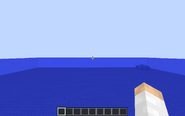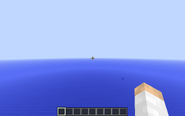- 10,502
- 11,573
The other thread is way too long and essentially about another topic so I will do a new one. Since this influences calcs it's better to debate it now instead of after stuff is revised, I think.
I asked about visibility at the beginning of the other thread before. I since looked a bit more into it I believe it is something we have to consider.
I doubt that one could actually see whether or not there are clouds 160km away in most circumstances, even if one has unobstructed view.
The reason is this. Essentially due to water vapor, dust and pollution it is always kinda foggy, even though in most cases we don't really notice even when looking at the horizon, since the horizon is closer than this effect usually becomes noticeable.
The further away one looks the more the contrast between objects decreases, due to the light being dispersed. That means at a certain distance a small patch/line of blue sky would become indistinguishable from the clouds and ground above and below it.
And, the thing is, we don't really notice whether the bit fog influences our perception of the horizon. The line where the ground becomes indistinguishable from the fog just looks like the horizon for us, regardless of whether that actually is the horizon.
Games are actually a great example for that. No game actually renders hundreds of kilometers. Game makers instead just introduce fog at the border of the render distance and that way get what looks like a realistic horizon. It is not known for its realism, but minecraft makes a great example here:

How the world actually looks like / fog disabled

How the same world looks like with fog activated
The second picture would for our current standards qualify as an unobstructed view on the horizon, despite the fact that it is impossible to see very far at all (not sure what the precise render distance was. 480m or so, I guess). That the fog is so light just makes it seem like an unobstructed view, even though it actually isn't.
In the article linked above it was said that one could rarely see further than 20km. That fits this, according to which in clear weather conditions the visibility is 20km, in very clear conditions 50km and exceptionally clear conditions even 280km.
So what I would suggest in practice is to restrict the upper end for horizon distance calcs to 20km low end and 50km high end, unless there is evidence otherwise.
Opinions?
I asked about visibility at the beginning of the other thread before. I since looked a bit more into it I believe it is something we have to consider.
I doubt that one could actually see whether or not there are clouds 160km away in most circumstances, even if one has unobstructed view.
The reason is this. Essentially due to water vapor, dust and pollution it is always kinda foggy, even though in most cases we don't really notice even when looking at the horizon, since the horizon is closer than this effect usually becomes noticeable.
The further away one looks the more the contrast between objects decreases, due to the light being dispersed. That means at a certain distance a small patch/line of blue sky would become indistinguishable from the clouds and ground above and below it.
And, the thing is, we don't really notice whether the bit fog influences our perception of the horizon. The line where the ground becomes indistinguishable from the fog just looks like the horizon for us, regardless of whether that actually is the horizon.
Games are actually a great example for that. No game actually renders hundreds of kilometers. Game makers instead just introduce fog at the border of the render distance and that way get what looks like a realistic horizon. It is not known for its realism, but minecraft makes a great example here:

How the world actually looks like / fog disabled

How the same world looks like with fog activated
The second picture would for our current standards qualify as an unobstructed view on the horizon, despite the fact that it is impossible to see very far at all (not sure what the precise render distance was. 480m or so, I guess). That the fog is so light just makes it seem like an unobstructed view, even though it actually isn't.
In the article linked above it was said that one could rarely see further than 20km. That fits this, according to which in clear weather conditions the visibility is 20km, in very clear conditions 50km and exceptionally clear conditions even 280km.
So what I would suggest in practice is to restrict the upper end for horizon distance calcs to 20km low end and 50km high end, unless there is evidence otherwise.
Opinions?